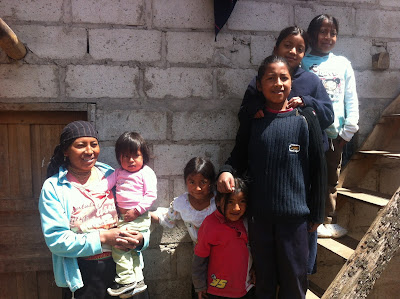Rosa and Rafael live on the steep hillsides above Mojanda. Like many other rural families they have been left behind by the world. Their small farm on an acre or two doesn't provide even enough food for the family to eat so Rafael travels to the city to work. Their main diet has been the corn that they harvested and a little bit that Rafael can buy with his meager pay.
How does SRA help? |
| Rosa and six of their seven children in front of their home |
When
The Institute for Self Reliant Agriculture (SRA) did a presentation of the program to their village they wanted to participate. In the process the first step is to sign a contract. The family commits to complete an evaluation at the beginning and the end of the program to measure its effectiveness. They also commit to attend the training classes on health, nutrition, agronomy, and animal care. The children need to be enrolled in the local school. At the end of the program the family will give back to SRA, for other families, seeds and animals like they have received. If the family will commit to do these things then the program begins.
 |
| The vegetable garden for a variety of vegetables They are harvesting every day. |
The evaluation and size measurements are done first to see the level of malnutrition in the family. Then a plan is set up as to what vegetables, grains, legumes, and animals will be used to fulfill the nutritional needs of the family. It is much more economical for these families to grow their own vegetables than to try and buy them in the market. Once the plan is set up, the lessons begin: nutrition, health, cooking with new vegetables, etc.
 |
| Alfalfa on the right, and recently planted corn and beans on the left. |
The agronomist teaches them to prepare the land for the different varieties of plants, what fertilizers to use, what illnesses and parasites to watch for, and how to treat them. He also helps them decide the quantity of the vegetables, grains, legumes, and forages that the will need to grow. Most families will have chickens for eggs and meat so they will need to raise corn for the chicken feed. They will usually have guinea pigs and a couple of goats so they need alfalfa to feed them. In the case of this family they have a sheep and some rabbits also.
 |
| The guinea pig are multiplying quickly |
This family was given one male and five female guinea pigs to start the program about a year ago. They now have about 40 guinea pigs and are able to eat about three each week as their protein source. The model stresses that their children's health is critical and they should
not sell any produce from their farm unless all of their nutritional needs have been met and they have stores for the next season.
With all agriculture projects there are ups and downs. Newcastle disease came through their area and wiped out all of the chickens before they were able to do anything about it. With another lesson learned SRA will get them more chickens to start again. That is one of the reasons that this is a multi-year project. In agriculture each year is a little different.
 |
| This is about 1/3 of this families grain storage, some for food and some for planting next season. |
This family has performed well. They have stored the corn, beans, barley, wheat and amaranth that they harvested this year. They have a years supply of their basic food needs and feed for their guinea pigs, rabbits, goats, chickens and sheep. All of it was grown on their own little farm. By the end of next year they should be totally self sufficient nutritionally and in a much better situation economically. SRA will do a final evaluation to see how well they are doing nutritionally and give them a graduation certificate. In most cases these family's diets will be much better than the average diet of children in the United States.
This family has already noticed the difference in their health, growth, and educational performance. If this family is like others that have finished the same program, the children will have good educations and will be able to get good employment, breaking the cycle of poverty in their family.
This program takes a lot of work and a lot of money for each family but the results for the family and indirectly to the community are long lasting. These families are taught how they can lift themselves out of poverty. They are then expected to teach and help others in the community to do the same.
The SRA program is one of the few programs that I have seen that doesn't create dependent people and leave
"monuments to philanthropic ignorance" in the villages. It changes lives for the better!!





Comments
Post a Comment